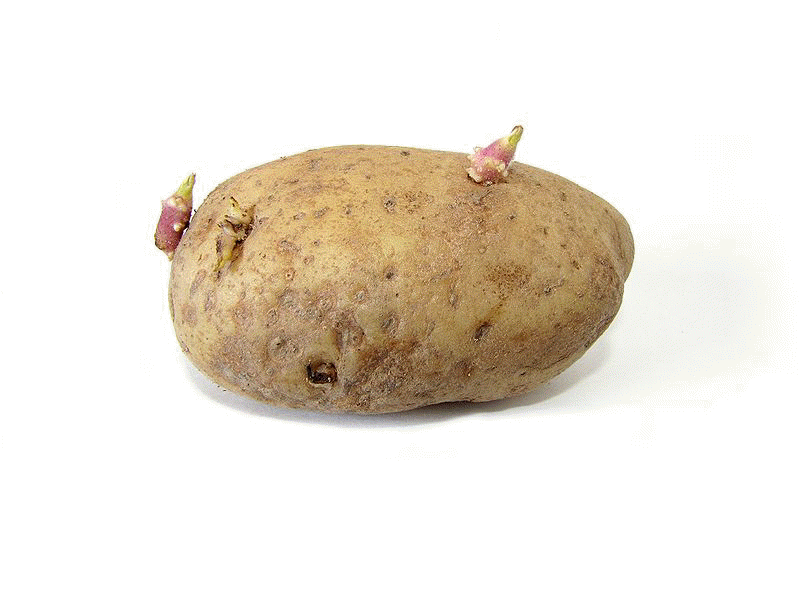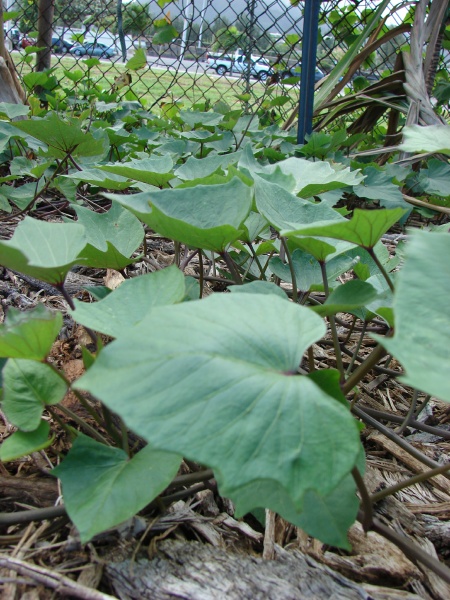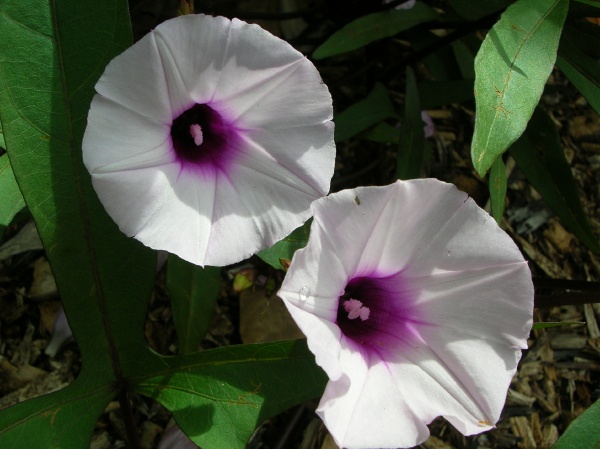
Classification and Phylogeny of I. batatas
I know Ipomoea batatas is the scientific name for the sweet potato, but what does it mean in English?
"Ipomoea" was derived from the Greek words ipos, meaning "bind weed," and homoios, meaning "resembling." When this is put together to form "Ipomoea" the direct translation is "resembling bindweed." This name makes sense because the sweet potato has a twining habit, much like the bindweed. The species name "batatas" was originally the Taino name for sweet potato. This name most likely spread by the Spanish who came in contact with sweet potatoes in Central America and brought them to the west indies. "Batata" is now the name for potato in Spanish.


Why does the Sweet potato belong to these classifications? –Read below!!
Domain: Eukarya –All members of this domain have membrane bound organelles such as chloroplasts and mitochondria. The word “Eukaryote” actually means “true nucleus” so an easy characteristic to distinguish eukaryotes from prokaryotes is whether or not the organism’s cells have at least one true nucleus. Sweat potato cells do, in fact, have a true nucleus that contains strands of DNA.
 Kingdom: Plantae- All members of this kingdom are photosynthetic which allows them to convert carbon dioxide and water into Oxygen and sugar, utilizing sunlight. Another feature of Plantae members is the cellulose wall that surrounds each of their cells. This allows for structural support, structure and rigidity of the organism.
Kingdom: Plantae- All members of this kingdom are photosynthetic which allows them to convert carbon dioxide and water into Oxygen and sugar, utilizing sunlight. Another feature of Plantae members is the cellulose wall that surrounds each of their cells. This allows for structural support, structure and rigidity of the organism.
Phylum: Magnoliophyta- All members of this phylum utilize seeds in early development. They contain vascular systems allowing them to transport water and nutrients to their cells. Also, these plants have flowers used in pollination processes. Another example species under this phyum is the Sweet Violet, or Viola Odorata.
Class: Eudicotyledones- The seeds of all members of this class have two cotyledons. Their flowers are usually broken into four or five parts (tetramerous or pentamerous). Leaf venation of a dicot is usually netlike. All dicots have secondary growth.
Order: Solanales- This order contains five families containing over 4,200 species of dicotyledonous flowering plants. Members feature flowers that are mostly monoecious, meaning both sexes are present in each flower.
Family: Convolvulaceae- Commonly referred to as the morning glory family of flowering plants. This family includes members that are found in both temperate and tropical environments. Many members are erect and twining herbs but some are trees, shrubs or woody vines.
 FACT: The Sweet potato is not closely related to the common white potato, or Solanum tuberosum. The white potato is a part of the Solanaceae family, which also includes eggplant, hot peppers, tobacco and tomatoes. What you will find in a grocery store from the common potato plant is called a tuber, which is basically a thickened base of the stem. Being a vine, sweet potatoes do not have tubers but instead have thick roots for starch storage.
FACT: The Sweet potato is not closely related to the common white potato, or Solanum tuberosum. The white potato is a part of the Solanaceae family, which also includes eggplant, hot peppers, tobacco and tomatoes. What you will find in a grocery store from the common potato plant is called a tuber, which is basically a thickened base of the stem. Being a vine, sweet potatoes do not have tubers but instead have thick roots for starch storage.
Genus: Ipomoea- This genus contains over 500 members making it one of the largest genera that fall under Convolvulaceae. Members are mostly found in warm climates and include herbaceous plants, shrubs and trees. Members of this genus feature flowers that are funnel shaped.
Species: Ipomoea batatas- This species is a widely cultivated food plant native to tropical America. Ipomoea batatas is a herbaceous perennial vine that has purplish flowers, large nutritious tuberous roots and heart-shaped lobed leaves.
What is happening in this phylogenetic tree???
 The Convolvulaceae family is broken up into two major clades. The first major clade including Cresseae, Dichondreae, Jaquemontieae, Cardiochlamyeae, and Cuscuteae, is known as the Dicranostyloideae clade and is based off of similar anatomy and morphology of these genera's seed dormancy. The second major clade including Ipomoea, Merremieae, Convolvuleae, and Aniseieae was named the Convolvuloideae clade. Again, based off of similar anatomy and morphology of the dormancy of these genera's seeds, this clade was formed.
The Convolvulaceae family is broken up into two major clades. The first major clade including Cresseae, Dichondreae, Jaquemontieae, Cardiochlamyeae, and Cuscuteae, is known as the Dicranostyloideae clade and is based off of similar anatomy and morphology of these genera's seed dormancy. The second major clade including Ipomoea, Merremieae, Convolvuleae, and Aniseieae was named the Convolvuloideae clade. Again, based off of similar anatomy and morphology of the dormancy of these genera's seeds, this clade was formed.
 The group of species under Ipomoea were branched according to their exon sequences which were analyzed by the Department of Biological sciences at Clemson University, South Carolina. Exon analysis broke Ipomoea into three major clades, separating I. littoralis, I. ramosissima, and I. umbraticola into the first clade. Ipomoea cyananchifolia, I. grandifolia, I. acunosa, I. tenuissima, I. tribola, and I. leaucantha had identical exon sequences in all 414 bases. Ipomoea tiliacea had a substitution at the 111th nucleotide. Ipomoea cordatotriloba had two nucleotide substitutions, one of which was the same as I. tiliacea, and the other was in nucleotide 320. This explains why those two species created a second minor clade. The third major clade including I. batatas shows a 98.8% similarity in nucleotide sequences between I. batatas and I. trifida while I. tabascana shows a 97.8% similarity in nucleotide sequences with I. batatas.
The group of species under Ipomoea were branched according to their exon sequences which were analyzed by the Department of Biological sciences at Clemson University, South Carolina. Exon analysis broke Ipomoea into three major clades, separating I. littoralis, I. ramosissima, and I. umbraticola into the first clade. Ipomoea cyananchifolia, I. grandifolia, I. acunosa, I. tenuissima, I. tribola, and I. leaucantha had identical exon sequences in all 414 bases. Ipomoea tiliacea had a substitution at the 111th nucleotide. Ipomoea cordatotriloba had two nucleotide substitutions, one of which was the same as I. tiliacea, and the other was in nucleotide 320. This explains why those two species created a second minor clade. The third major clade including I. batatas shows a 98.8% similarity in nucleotide sequences between I. batatas and I. trifida while I. tabascana shows a 97.8% similarity in nucleotide sequences with I. batatas.
You are now an expert on how this organism fits into its family tree. Next stop...how the sweet potato reproduces!

